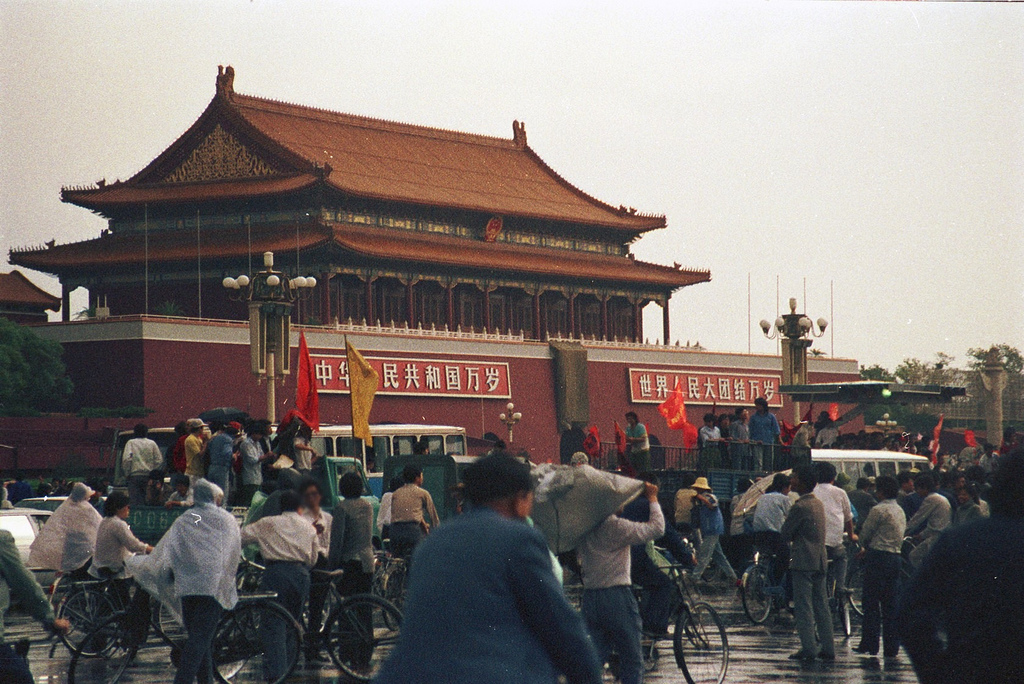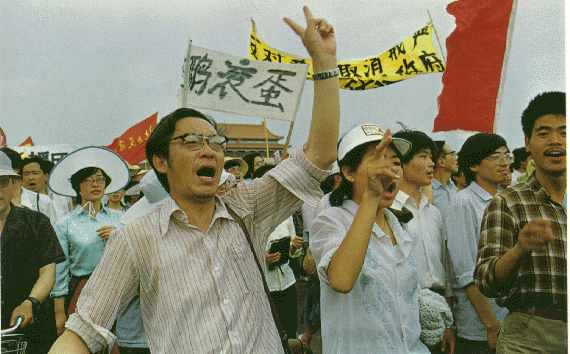Photo: Yangshuo, by Rod Waddington

Yangshuo
© josh rudolph for China Digital Times (CDT), get_post_time('Y'). |
Permalink |
No comment |
Add to
del.icio.us
Post tags:
Download Tools to Circumvent the Great Firewall


 30 Years Ago: Changes at Top Are Hinted
30 Years Ago: Changes at Top Are Hinted
This year marks the 30th anniversary of the nationwide, student-led democracy movement in China, and the subsequent June 4th military crackdown in Beijing. To commemorate the student movement, CDT is posting a series of original news articles from 1989, beginning with the death of Hu Yaobang on April 15 and continuing through the tumultuous spring.
From the May 24, 1989 New York Times:
As hundreds of thousands of people demonstrated in Beijing and Shanghai for the ouster of Prime Minister Li Peng, China’s top leaders met in secret in the capital on Tuesday and appeared to make significant progress in breaking the political deadlock.
Early this morning, there were signs that Zhao Ziyang, the Communist Party leader, who was stripped of his powers late last week after he urged a moderate line toward students demonstrating for democracy, might be making a comeback.
There were also hints in official news reports that Mr. Li might be in political trouble, and military troops began to withdraw from some of their positions in the capital.
The most striking sign of a change in the power struggle came early this morning when news organizations for the first time in several days referred to Mr. Zhao and identified him as still being the General Secretary of the Communist Party. [Source]
From the May 24, 1989 Los Angeles Times:
A Hong Kong radio station reported that the ruling Communist Party Politburo met Tuesday and decided that Li should lose both his position as premier and his place on the five-member Standing Committee of the Politburo. The report could not be immediately confirmed, but there was strong evidence that Li cannot remain in power.
Communist Party General Secretary Zhao Ziyang, who favors rapid economic and political liberalization, appeared best positioned to emerge as China’s No. 1 leader. But someone else might come out on top when the current crisis is resolved.
“Truth Triumphs Over Power,” declared a banner hanging on the side of the Chinese Academy of Social Sciences building along Tuesday’s parade route. At the head of the march were intellectuals from the influential think tank, which is controlled by the Communist Party but also is a center of reformist sentiment. Some described Li’s action last week in declaring martial law as an attempt at a military coup. [Source]
Also from another article in the same day’s New York Times:
Not many Chinese follow Italian politics, so perhaps it was a bit surprising for People’s Daily to carry a small front-page article Sunday on the resignation of the Italian Government.
But in China, where subtlety is a way of journalism as of life, the message was obvious: China’s Government should think about resigning as well. Such hints are still as much a part of Chinese newspapers as ink and paper, but the last few weeks has seen a minor revolution in what newspapers can publish.
As a result, the hints are getting ever bolder, and sometimes newspapers even make their point outright. In a dramatic contrast to the press coverage before the student demonstrations began more than five weeks ago, China’s news organizations can now cover events that the Government would perhaps rather hush up.
Some say a semi-independent press may be the democracy movement’s greatest achievement and a significant spur to further liberalization. [Source]
Also, from the same paper, “Chinese take Umbrage At Attack on Mao Portrait.”
[This series was originally posted by CDT in 2009 to mark the 20th anniversary of the protests. If you have access to additional sources of original reporting, video, accounts or photos from the spring of 1989, please send them to us at cdt@chinadigitaltimes.net and we’ll consider including them in this series. Many thanks.]
© cindy for China Digital Times (CDT), get_post_time('Y'). |
Permalink |
No comment |
Add to
del.icio.us
Post tags: 1989 protests, 1989 timeline series, ccp leadership, Li Peng, Zhao Ziyang
Download Tools to Circumvent the Great Firewall


 “Speaking of Forbidden Histories” as June 4th Approaches
“Speaking of Forbidden Histories” as June 4th Approaches
With the 30th anniversary of the June 4, 1989 military crackdown on protesters approaching, many participants and observers are working to keep memories of the events alive amid government efforts to squelch them. For 30 years, the Communist Party has stifled any public mention of the events of 1989 and has not held any public accounting for the deaths that resulted nor allowed family members of those killed to publicly mourn their loved ones. In an article that is part of a six-part series in the South China Morning Post, Jun Mai writes about why the Party is so determined not to revisit that episode in the country’s history:
Perry Link, a sinologist with Princeton University, said the party’s insecurity and obsession with holding on to power made it hard for the leadership to reopen the case.
“They fear opening the case again for honest discussions of the horrors in the past could snowball into another popular revolt,” said Link, a co-editor of The Tiananmen Papers – a compilation of selected secret Chinese official documents relating to crackdown, which Beijing denounced as fake when published in 2001.
“[The leadership thinks] the cost it loses by repressing the truth is much less than the costs it stands to lose by telling the truth.”
Bao Pu, the son of Zhao’s top aide Bao Tong, said the current leadership might have to face the question of its legitimacy if it allowed people to discuss the event.
“The party’s legitimacy was lost the moment it ordered the army to open fire on the peaceful protesters … it is counting on the public to forget about it. [Source]
In another article for the same SCMP series, Josephine Ma and Guo Rui interview family members who have spent the last three decades calling for a full investigation into the deaths of their loved ones. They also look at the negative consequences that have resulted from the government’s refusal to confront the issue:
But no vindication has come. Instead, the party has stuck to its verdict, defining the pro-democracy protests as “turmoil”, “counter-revolutionary riots” and “an act against the government”.
For three decades, it has firmly resisted revisiting the period, turning its back on the reformist calls of the time and stifling debate to maintain stability and its own survival.
But observers and insiders say that the party and the country are paying a price for the three-decade-old strategy. They say that by exiling critics to the political wilderness, and by hewing to its authoritarian line, the party’s ability to face challenges will be undermined by the lack of checks and balances. It will also miss the opportunity to clear the stain on its reputation abroad by reconciling with the victims’ families while they are still alive. [Source]
June 4th is one historic episode among many that have been defined and rewritten by the Communist Party. In recent weeks, the Party has worked to impose its own version of the history of the 1919 May 4th student movement, marking its 100th anniversary this year. In The Guardian, Ilaria Maria Sala and Louisa Lim write about the moral necessity of accurately remembering the traumatic events of 1989–which Sala witnessed and Lim wrote about in her book “The People’s Republic of Amnesia”–along with other influential events from Chinese history:
With politics firmly in command over history, almost every aspect of China’s past risks becoming a battlefield. In recent years US scholars researching the history of the last imperial dynasty, the Qing (1636-1911), have been vilified by state-run Chinese newspapers for historical nihilism and imperialism. This is because their close examination of how the Qing came to conquer Xinjiang, Tibet, Mongolia and Taiwan ultimately invalidates China’s assertions that all areas under its control are “inalienable parts of China” since time immemorial.
In this way, political no-go zones are scattered throughout the long millennia of Chinese history and scholars lament how much access to archives is being restricted, in particular for topics still little explored, such as the actions and fate of Chinese collaborators of Japanese invaders during the Second World War or issues that touch upon ethnic tensions, whether in inner Mongolia or Tibet.
[…] If events that happened centuries ago are this controversial, imagine how perilous it is to walk the censored days of that Beijing spring just 30 years ago. In this climate, where silence is acquiescence, speaking of forbidden histories becomes a moral choice. [Source]
For more about the events of 1989 and how they were covered by global media, see CDT’s series of daily posts with links to original news reporting from throughout that spring.
© Sophie Beach for China Digital Times (CDT), get_post_time('Y'). |
Permalink |
No comment |
Add to
del.icio.us
Post tags: 1989 protests, accountability, June 4th, PRC history, revisionism, transparency
Download Tools to Circumvent the Great Firewall


 30 Years Ago: Shortages Begin to Cripple Beijing
30 Years Ago: Shortages Begin to Cripple Beijing
This year marks the 30th anniversary of the nationwide, student-led democracy movement in China, and the subsequent June 4th military crackdown in Beijing. To commemorate the student movement, CDT is posting a series of original news articles from 1989, beginning with the death of Hu Yaobang on April 15 and continuing through the tumultuous spring.
From the May 23, 1989 New York Times:
As the capital ends its third day of martial law, Beijing is finding itself crippled by shortages and disruptions of vital services. In the absence of an effective government in parts of the city, only student rule seems to have averted total collapse in the city.
Mail delivery has become sporadic and traffic jams abound. Most subway and bus service has been suspended. As a result, workers are forced to ride bicycles or walk, and they often arrive late to work, if they arrive at all.
There are desperate shortages of gasoline, electricity, vegetables, milk and eggs. Some key roads into the city are blocked by military convoys and citizens surrounding them, and the distribution network seems to have been further hampered by roadblocks and demonstrations throughout the city. ‘Very Hard to Do Business’
”It’s very hard to do business now,” said a diplomat here. ”When we invited some officials to lunch, they said they couldn’t drive here because once they got out of their compound their drivers would join the demonstrators. So we had to send a diplomatic car to fetch them.” [Source]
From an op-ed by A.M. Rosenthal from the same day’s New York Times:
The truth of what has happened in China is so startling that even now the world hardly takes it in. For a time, the Government of the world’s most populous country has lost its power to govern and control the nation. When that happens a Government is in effect overthrown until it shows it can resume control.
Since no other authority is available to step in, the Chinese Government will probably be able to pull together what remains of its influence and summon the power to direct the nation once more.
But the fact that there was a time in May 1989 when the Government of China was overthrown as the real controlling authority will become part of China’s history and is certain to affect China’s future. [Source]
From beijing.may89, taken on May 23, 1989:

The Mao portrait was covered – just for a couple of hours. It had been defiled by paint or something, and it was quickly covered up until it was replaced by a new portrait. The atmosphere was very special and strange, a little eerie and scary too. [Source]
For more photos, see beijing.may89’s Photostream.
Also from this date in 1989: “China Army Leaders Vow not to Attack” from AP and an editorial from the New York Times, “After the Students Go Home.”
 Protesters come from all walks of life and all age groups as they march in Beijing on May 23, 1989 (via CND)
Protesters come from all walks of life and all age groups as they march in Beijing on May 23, 1989 (via CND)
[This series was originally posted by CDT in 2009 to mark the 20th anniversary of the protests. If you have access to additional sources of original reporting, video, accounts or photos from the spring of 1989, please send them to us at cdt@chinadigitaltimes.net and we’ll consider including them in this series. Many thanks.]
© cindy for China Digital Times (CDT), get_post_time('Y'). |
Permalink |
No comment |
Add to
del.icio.us
Post tags: 1989 protests, 1989 timeline series, Mao portrait
Download Tools to Circumvent the Great Firewall


